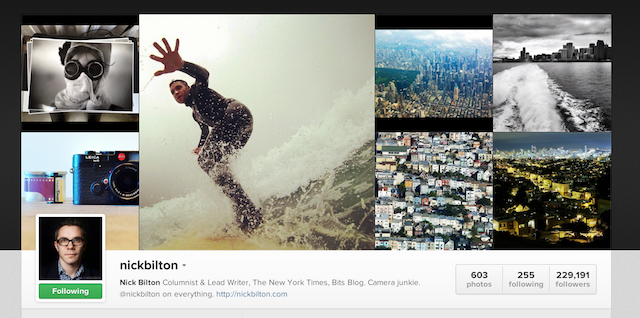Yesterday, Instagram launched web profiles. To some, they’re lovely. To others, they’re long overdue. And to a great many, they’re ho-hum — an obvious way to inject yet another zinger about Facebook buying the startup for a billion dollars (but actually *only* $700-something million — ZING!).
To me, these profiles are actually a very clear window into why Facebook would spend so much money to acquire Instagram. These profiles realize the unfulfilled vision of Facebook’s Timeline feature and perhaps take it a step further.
Right now, looking at my own Instagram profile is fun. It’s a nice way to revisit my recent pictures. With a simple tweak to better surface images from my history, it becomes pure, powerful nostalgia.
But looking at the profiles of other people is even more revealing. It’s a visual representation of someone to an extent that hasn’t been achieved before. And it’s created without the user having to do any work beyond what they’ve already done (taking the initial picture). These profiles say a lot about a person — all without saying a word.
Looking at the profiles of people I know is pretty potent. It’s unmistakably them, but in a way I hadn’t considered before. It’s a visual autobiography.
When you hear that Instagram’s user growth trajectory has them set to eclipse Twitter — perhaps even next year — and that their daily usage numbers may already have, it’s shocking at first. But it shouldn’t be shocking at all. Words are hard. Typing takes effort. People are worried they’re going to say something stupid. There are language barriers. A 140 character limit helps a bit, but it also hurts in other ways.
Pictures are universal. Smartphones have made them realtime, all the time. And apps like Instagram have turned them into a visual language. It was the perfect storm at the perfect time to create a new form of communication.

The single most important thing that Instagram has done is turn everyone into a picture-taker. You may be a great one. You may think you’re a great one. Or you may be a shitty one. It doesn’t matter. What matters is that you’re taking pictures. You’re communicating and documenting your life in a way most people never would or will with text.
When you’re just taking one picture, you may not realize you’re recording a passage in the book of you, but you are. And the fact that these pictures are geotagged and timestamped is the binding of this book.
It’s the visual profile of you. And as 100 million Instagram users meld into 1 billion Facebook users, it’s the visual profile of everyone.
Facebook’s Timeline feature was and is genius. But it’s too complicated. Events, job milestones, travel, marriages, break-ups, text, photos, videos, etc. The fact that most of it has to be added manually in the present day is bad enough. But the true power of Timeline should be the entire timeline of your life — only no one is going to go back to add those elements from the past. And even if they wanted to, it’s hard to remember all the correct data.
I always thought it would be smart for Facebook to offer to scan collections of old pictures for free. Just have people send them in or work with Walmart to scan them in store and immediately put them into Timeline. If they have timestamps, it would be pretty simple. If not, create a tool to let users easily place bundles in the general date range of when they were taken and where. Boom. Instant actual Timeline — not just Timeline from 2008 (or whenever you signed up for Facebook).
This would be both an incredible powerful user lock-in agent for Facebook and, more importantly, a killer feature for users. I must have 10,000 photos under my old bed in Ohio. I’m not sure I’ll ever look at them again, which is both ridiculous and sad.

Instagram is the key to Timeline going forward — but indirectly. Photos have always been an important element of Facebook (and some would argue the most important element of Facebook). Before the prevalence of smartphones, getting them into Facebook was far too cumbersome. And even with smartphones, Facebook wasn’t best-suited for this because not everyone was a photo-taker all the time.
Facebook’s scale quickly made them the largest photo service, but it wasn’t because it was a great photo service by any means.
This is why Facebook developed and released their own Camera app. It was never going to be Instagram, but they wanted to try to capture the spirit of everyone taking pictures all the time. Along the way, they were able to capture Instagram itself. A truly brilliant move.
The other brilliant move: allowing Instagram to continue to exist as a stand-alone service. The many other elements of Facebook would clutter and distort the visual language Instagram has created. The idea should be to use these images to augment the more robust Facebook, but keep the picture network intact and seamless. Nothing can halt a great conversation in Japanese faster than someone yelling in French.
More so than ever before in our history, the picture is a form of expression and communication that can rival the written word. And in many ways, it’s better. We’re seeing this play out right now. It’s the actualization of “a picture is worth a thousand words” at scale.
That, in turn, is easily worth $1 billion. Give or take.

